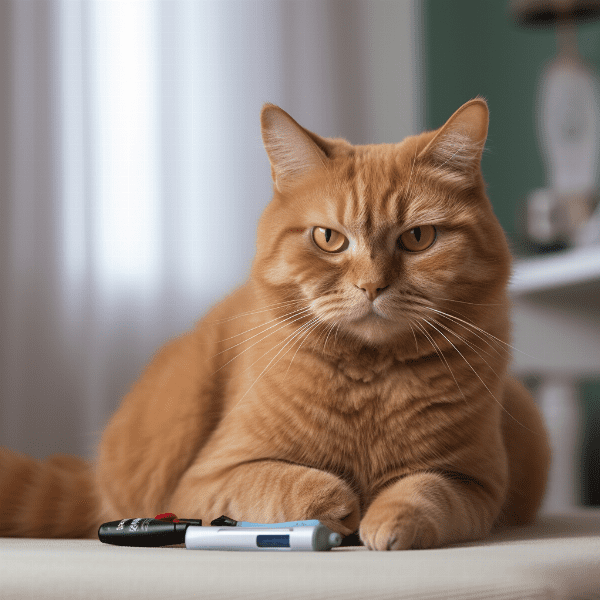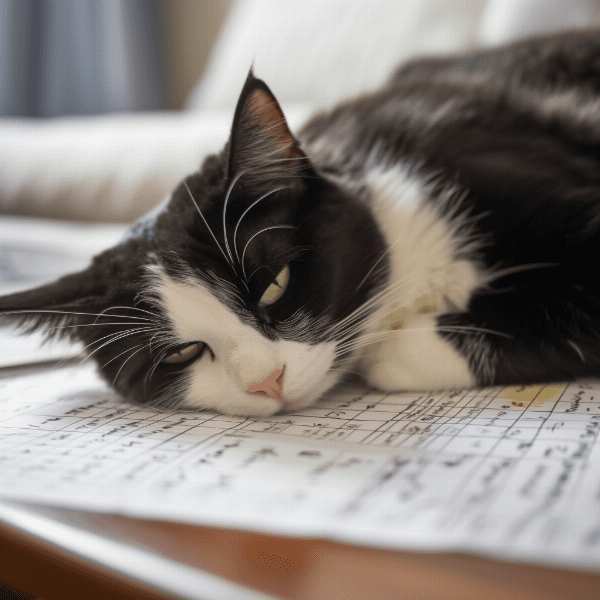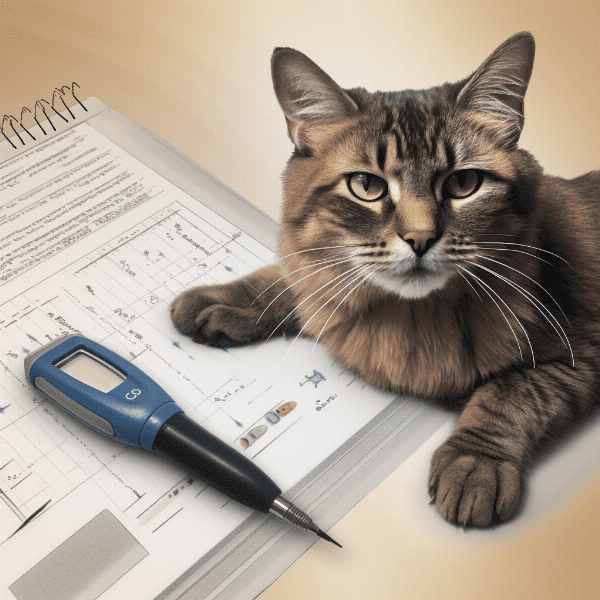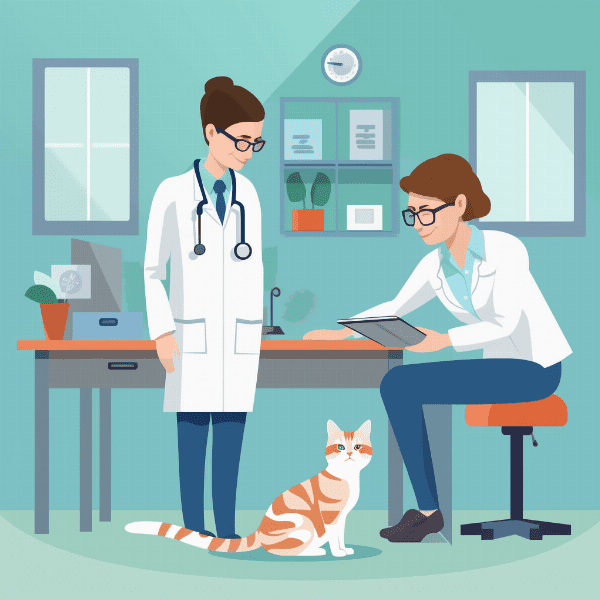Table of Contents
- Understanding Feline Diabetes
- Signs and Symptoms of Cat Diabetes
- Diet and Nutrition for Managing Cat Diabetes
- Exercise and Activity for Cat Diabetes Management
- Alternative Treatments for Cat Diabetes
- Monitoring Blood Glucose Levels in Cats
- Home Care for Diabetic Cats
- Working with Your Veterinarian to Manage Cat Diabetes
- Potential Complications of Untreated Cat Diabetes
- Conclusion and Future Outlook for Cat Diabetes Management
Understanding Feline Diabetes
Feline diabetes is a chronic disease that affects cats of all ages and breeds. It occurs when a cat’s body cannot produce or utilize insulin effectively, leading to high blood glucose levels. Insulin is a hormone produced by the pancreas that regulates the amount of glucose in the bloodstream. Without enough insulin, the body cannot convert glucose into energy, causing various health problems.
Causes of Feline Diabetes
The exact causes of feline diabetes are not fully understood. However, several factors have been linked to the development of the disease. These include genetics, obesity, age, and certain medical conditions such as pancreatitis or hyperthyroidism.
Symptoms of Feline Diabetes
Some common signs and symptoms of feline diabetes include increased thirst and urination, weight loss despite increased appetite, lethargy, and poor coat condition. These symptoms can develop gradually over time, making it difficult to detect the disease in its early stages.
Types of Feline Diabetes
There are two types of feline diabetes – type 1 and type 2. Type 1 diabetes occurs when the pancreas is unable to produce enough insulin, while type 2 diabetes happens when the body becomes resistant to insulin. Type 2 diabetes is more common in overweight and obese cats.
Risk Factors for Feline Diabetes
Several risk factors can increase a cat’s likelihood of developing diabetes. These include obesity, age (cats over 7 years old are more susceptible), male gender, and certain breeds such as Burmese, Siamese, and Himalayan cats.
Understanding the causes, symptoms, types, and risk factors of feline diabetes is crucial in managing the disease. If you suspect that your cat may have diabetes, it’s important to seek veterinary care as soon as possible to prevent further complications.

Signs and Symptoms of Cat Diabetes
As a responsible cat owner, it’s important to be aware of the signs and symptoms of feline diabetes. Early detection and treatment can prevent serious health complications and improve your cat’s quality of life. Here are some common signs and symptoms to look out for:
Increased Thirst and Urination
One of the most common signs of feline diabetes is increased thirst and urination. If your cat is drinking more water than usual and urinating more frequently, it may be a sign of high blood sugar levels. The body tries to eliminate excess glucose through urine, causing increased urination.
Weight Loss Despite Increased Appetite
Another common symptom of feline diabetes is weight loss despite an increased appetite. The body cannot utilize glucose properly, causing the cat to lose weight even though it is eating more food. If your cat is losing weight but still seems hungry all the time, it’s important to get them checked for diabetes.
Lethargy and Weakness
Diabetic cats may also experience lethargy and weakness. They may seem less active and have less energy than usual. This is because the body is unable to use glucose for energy, causing fatigue and weakness.
Poor Coat Condition
Cats with diabetes may also have a poor coat condition. Their fur may become dull, dry, and thin due to the body’s inability to utilize nutrients properly.
Increased Hunger
In some cases, diabetic cats may also experience increased hunger. This is because the body is not able to use glucose properly, causing hunger pangs and cravings.
Recognizing the signs and symptoms of feline diabetes is important for early detection and treatment. If you notice any of these symptoms in your cat, it’s important to schedule a veterinary appointment as soon as possible.

Diet and Nutrition for Managing Cat Diabetes
Choosing the Right Food
One of the most important aspects of managing feline diabetes is choosing the right food for your cat. Look for high-quality cat food that is low in carbohydrates and high in protein. Avoid foods that contain high levels of carbohydrates or sugar, which can cause blood sugar spikes.
Feeding Schedule
Establishing a regular feeding schedule can also help manage feline diabetes. Feed your cat at the same time every day and in the same amount. This helps regulate their blood sugar levels and prevents overeating.
Portion Control
Portion control is crucial for diabetic cats. Overeating can cause blood sugar spikes, which can lead to serious health complications. Work with your veterinarian to determine the appropriate portion size for your cat’s needs.
Treats
While treats can be a great way to reward your cat, they should be given in moderation for diabetic cats. Choose low-carbohydrate, high-protein treats that are specifically designed for diabetic cats.
Water Intake
Cats with diabetes may drink more water than usual, so it’s important to provide fresh water at all times. Dehydration can lead to serious health complications, so make sure your cat is drinking enough water.
Supplemental Nutrients
Certain supplements can also be beneficial for diabetic cats. For example, omega-3 fatty acids may help reduce inflammation and improve insulin sensitivity. Talk to your veterinarian about the best supplements for your cat’s needs.

Exercise and Activity for Cat Diabetes Management
In addition to diet and nutrition, exercise and activity can also play a key role in managing feline diabetes. Regular physical activity can help regulate blood sugar levels and improve your cat’s overall health. Here are some important considerations when it comes to exercise and activity for cat diabetes management:
Types of Exercise
There are several types of exercise that are suitable for diabetic cats. For example, playing with toys that encourage activity, such as balls or interactive toys, can help keep your cat active and engaged. Additionally, setting up a climbing structure or scratching post can encourage your cat to move around and exercise.
Exercise Frequency
The frequency of exercise will depend on your cat’s individual needs. Some cats may need more exercise than others, depending on their age, weight, and overall health. Work with your veterinarian to determine an appropriate exercise plan for your cat.
Monitoring Blood Sugar Levels
It’s important to monitor your cat’s blood sugar levels before and after exercise to ensure that they are not experiencing blood sugar spikes or drops. Talk to your veterinarian about the best way to monitor your cat’s blood sugar levels at home.
Safety Considerations
When it comes to exercise and activity, safety is paramount for diabetic cats. Avoid activities that could cause injury, such as jumping from high surfaces or running up and down stairs. Additionally, make sure your cat has access to plenty of fresh water during and after exercise.
Outdoor Activity
If your cat enjoys outdoor activity, consider taking them for a walk on a leash or setting up an outdoor play area that is safe and secure. However, make sure to monitor your cat closely and keep them away from potential hazards such as traffic or other animals.
By incorporating regular exercise and activity into your cat’s routine, you can help manage their diabetes and improve their overall health. Work with your veterinarian to develop an exercise plan that is tailored to your cat’s individual needs.

Alternative Treatments for Cat Diabetes
In addition to traditional medical treatments such as insulin therapy and prescription diets, there are also alternative treatments that may be helpful for managing feline diabetes. Here are some alternative treatments to consider:
Acupuncture
Acupuncture is a complementary therapy that involves inserting fine needles into specific points on the body. Some studies have suggested that acupuncture may help improve insulin sensitivity and regulate blood sugar levels in diabetic cats.
Herbal Remedies
Certain herbs and supplements may also be beneficial for managing feline diabetes. For example, bitter melon, gymnema, and fenugreek have all been used in traditional medicine to help regulate blood sugar levels. However, it’s important to talk to your veterinarian before giving your cat any herbal remedies or supplements, as they may interact with other medications or have potential side effects.
Homeopathy
Homeopathy is a holistic approach to medicine that involves using highly diluted natural substances to stimulate the body’s own healing mechanisms. Some homeopathic remedies may be helpful for managing feline diabetes, although more research is needed to fully understand their effectiveness.
Massage Therapy
Massage therapy can also be a helpful complementary therapy for diabetic cats. Massage can help improve circulation and promote relaxation, which may help reduce stress and improve insulin sensitivity.
Stress Reduction Techniques
Stress can have a negative impact on blood sugar levels in diabetic cats. Therefore, stress reduction techniques such as play therapy, behavior modification, and aromatherapy may be helpful for managing feline diabetes.
While alternative treatments may be helpful for managing feline diabetes, it’s important to talk to your veterinarian before trying any new therapies. Your veterinarian can help you determine which treatments are safe and effective for your cat’s individual needs.

Monitoring Blood Glucose Levels in Cats
Monitoring your cat’s blood glucose levels is an important part of managing feline diabetes. Regular monitoring can help you determine if your cat’s treatment plan is working effectively and can prevent serious health complications. Here are some important considerations when it comes to monitoring blood glucose levels in cats:
Blood Glucose Testing
There are several ways to monitor your cat’s blood glucose levels, including blood glucose testing at home or at the veterinarian’s office. Home blood glucose testing involves pricking your cat’s ear or paw to obtain a small drop of blood, which is then analyzed using a blood glucose meter. Your veterinarian can teach you how to perform blood glucose testing at home.
Target Blood Glucose Levels
The target blood glucose levels for diabetic cats can vary depending on the severity of the disease and your cat’s individual needs. Your veterinarian can help you determine the appropriate target blood glucose levels for your cat and adjust their treatment plan as needed.
Testing Frequency
The frequency of blood glucose testing will depend on your cat’s individual needs. Some cats may need to be tested multiple times a day, while others may only need to be tested once or twice a week. Your veterinarian can help you determine the appropriate testing frequency for your cat.
Record Keeping
Keeping detailed records of your cat’s blood glucose levels, diet, and exercise routine can help you and your veterinarian monitor their progress and make adjustments to their treatment plan as needed. Consider keeping a logbook or using a mobile app to track your cat’s health data.
Adjusting Treatment Plan
Regular blood glucose monitoring is crucial for managing feline diabetes. Work closely with your veterinarian to develop a monitoring plan that is tailored to your cat’s individual needs.

Home Care for Diabetic Cats
Managing feline diabetes requires ongoing care and attention, both at home and with the help of a veterinarian. Here are some important considerations when it comes to home care for diabetic cats:
Insulin Administration
If your cat requires insulin therapy, it’s important to administer the insulin at the same time every day and in the correct dosage. Your veterinarian can teach you how to administer insulin injections at home and provide guidance on how to monitor your cat’s blood glucose levels.
Diet and Nutrition
Feeding your cat a healthy, balanced diet that is low in carbohydrates and high in protein is important for managing feline diabetes. Work with your veterinarian to develop a personalized nutrition plan for your cat and consider feeding them small, frequent meals throughout the day.
Exercise and Activity
Regular exercise and activity can help regulate blood sugar levels and improve your cat’s overall health. Consider setting up a safe, indoor play area for your cat and incorporating toys that encourage activity.
Monitoring Blood Glucose Levels
Regular blood glucose monitoring is important for managing feline diabetes. Work with your veterinarian to determine the appropriate testing frequency for your cat and keep detailed records of their blood glucose levels and other health data.
Medication and Supplement Administration
If your cat requires medications or supplements for their diabetes or other health conditions, it’s important to administer them at the same time every day and in the correct dosage. Follow your veterinarian’s instructions carefully and keep track of when you administer each medication or supplement.
Regular Veterinary Check-Ups
Regular check-ups with your veterinarian are crucial for monitoring your cat’s health and adjusting their treatment plan as needed. Make sure to schedule regular appointments for blood glucose testing, physical exams, and other necessary tests.
Managing feline diabetes at home requires a commitment to ongoing care and attention. Work closely with your veterinarian to develop a personalized treatment plan for your cat and stay vigilant when it comes to monitoring their health.

Working with Your Veterinarian to Manage Cat Diabetes
Managing feline diabetes requires a collaborative effort between you and your veterinarian. Here are some important considerations when it comes to working with your veterinarian to manage your cat’s diabetes:
Regular Check-Ups
Regular check-ups with your veterinarian are crucial for monitoring your cat’s blood glucose levels, adjusting their treatment plan as needed, and addressing any health concerns that may arise. Make sure to schedule regular appointments and follow your veterinarian’s recommendations for testing and monitoring.
Communication
Effective communication is key when it comes to managing feline diabetes. Make sure to keep your veterinarian informed of any changes in your cat’s health, including changes in appetite, behavior, or activity level. Additionally, don’t hesitate to ask questions or voice concerns about your cat’s treatment plan.
Treatment Plan Adjustments
If your cat’s blood glucose levels are consistently outside of their target range, it may be necessary to adjust their treatment plan. This may involve changing their diet, adjusting their insulin dosage, or incorporating new therapies. Work closely with your veterinarian to determine the best course of action.
Emergency Preparedness
In the event of a diabetic emergency, it’s important to be prepared. Make sure to have a plan in place for what to do if your cat experiences a blood sugar spike or drop, and keep emergency contact information for your veterinarian on hand.
Collaboration with Specialists
In some cases, your veterinarian may refer you to a specialist for further evaluation and treatment. It’s important to work closely with any specialists involved in your cat’s care to ensure that all aspects of their health are being properly addressed.
Working closely with your veterinarian is essential for managing feline diabetes. By staying informed, communicating effectively, and following your veterinarian’s recommendations, you can help ensure that your cat receives the best possible care.

Potential Complications of Untreated Cat Diabetes
Untreated feline diabetes can lead to a variety of serious health complications. Here are some potential complications to be aware of:
Diabetic Ketoacidosis
Diabetic ketoacidosis is a potentially life-threatening condition that occurs when there is a severe insulin deficiency in the body. It can cause a variety of symptoms, including vomiting, dehydration, and lethargy. Immediate veterinary attention is necessary to treat diabetic ketoacidosis.
Hypoglycemia
Hypoglycemia, or low blood sugar, can occur in diabetic cats who are receiving too much insulin or not enough food. It can cause symptoms such as weakness, lethargy, and seizures. Immediate veterinary attention is necessary to treat hypoglycemia.
Infections
Diabetic cats are at an increased risk of developing infections, particularly urinary tract infections and skin infections. These infections can be difficult to treat and may require long-term antibiotic therapy.
Neuropathy
Neuropathy is a nerve disorder that can occur in diabetic cats who have high blood sugar levels for an extended period of time. It can cause symptoms such as weakness, loss of coordination, and difficulty walking.
Cataracts
Diabetic cats are also at an increased risk of developing cataracts, a condition that causes cloudiness in the eyes and can lead to blindness if left untreated.
Organ Damage
Over time, untreated feline diabetes can cause damage to organs such as the kidneys, liver, and pancreas. This damage can lead to serious health complications and may be irreversible.
By working closely with your veterinarian to manage your cat’s diabetes, you can help prevent these potential complications and ensure that your cat stays healthy and happy. Regular check-ups, blood glucose monitoring, and prompt treatment of any health issues are crucial for managing feline diabetes and preventing serious complications.

Conclusion and Future Outlook for Cat Diabetes Management
Managing feline diabetes requires a multifaceted approach that includes regular veterinary care, monitoring blood glucose levels, and making lifestyle changes such as diet and exercise modifications. While traditional treatments such as insulin therapy and prescription diets are effective in managing feline diabetes, there are also alternative therapies that may be beneficial.
In the future, advancements in veterinary medicine may lead to new treatments and therapies for managing feline diabetes. Researchers are currently exploring the potential of gene therapy, stem cell therapy, and other innovative treatments for diabetic cats.
Overall, the key to managing feline diabetes is early diagnosis, ongoing veterinary care, and a commitment to lifestyle changes that promote good health. By working closely with your veterinarian and taking an active role in your cat’s care, you can help ensure that your cat lives a happy and healthy life despite their diabetes diagnosis.
If you suspect that your cat may have diabetes, don’t hesitate to schedule an appointment with your veterinarian. With proper care and management, diabetic cats can live long, healthy lives.




